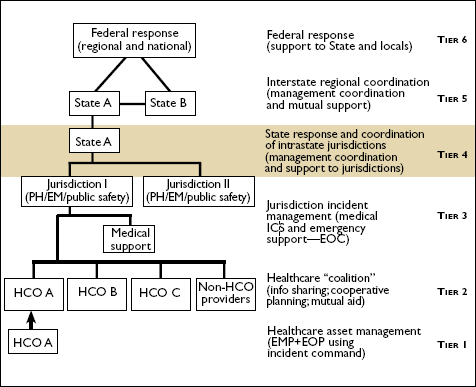Chapter 5: Management of State Response and Coordination of Intrastate Jurisdictions (Tier 4)Contents Management of State Response and Coordination of Intrastate Jurisdictions (Tier 4)  Tier 4 encompasses all State agencies that are responsible for emergency management, public health, and public safety preparedness and response. It addresses situations in which the State is considered the lead incident command authority, and those in which the State coordinates multijurisdictional incident management (Tier 3). Key Points of the Chapter The role of State Government in providing MSCC will vary based on incident circumstances and State-specific regulations. In general, however, States may enhance MSCC by: - Assisting jurisdictional incident management (Tier 3) when local resources are severely challenged
- Providing primary incident command in widespread emergencies that reach to a state-wide level of responsibility
- Providing State resources to assist the local response
- Coordinating with incident management in other affected States
- Integrating State and jurisdictional response efforts with Federal support (Tier 6).
The State Emergency Management Program (EMP) should fully integrate public health and acute-care medicine with traditional response disciplines (e.g., fire/EMS, law enforcement). This will benefit State emergency health initiatives, such as bioterrorism preparedness, by promoting interdisciplinary cooperation. It will also benefit non-health-related emergency response by providing an integrated public health and medical perspective. An important focus of the State EMP should be developing management processes that facilitate integration between State-based and local or jurisdictional authorities. Experience has shown that coordination across jurisdictional boundaries must be carefully addressed to promote an effective emergency or disaster response. State-level incident management can strengthen multijurisdictional response by coordinating management teams in affected jurisdictions. This is best accomplished through a robust Tier 4 information management function, established in the Planning Section of the State's incident management team, or alternatively, in the State's Multiagency Coordination Center (MACC). In addition, the coordination of tactical mutual aid between intrastate jurisdictions brings health and medical resources to areas of greatest need. Strategic or "master" mutual aid guidelines developed by the State during preparedness planning facilitate this aid distribution. In incidents where the State has primary incident command authority, State public health and medical managers should organize as part of the State's unified command, rather than attempt to manage incident response through Emergency Support Function (ESF) positions in the State Emergency Operations Center (EOC). << Previous --------- Top of Page --------- Next >>
| 
 Print
Print  Download Reader
Download Reader 

 Print
Print  Download Reader
Download Reader 